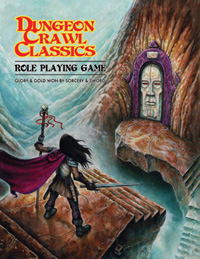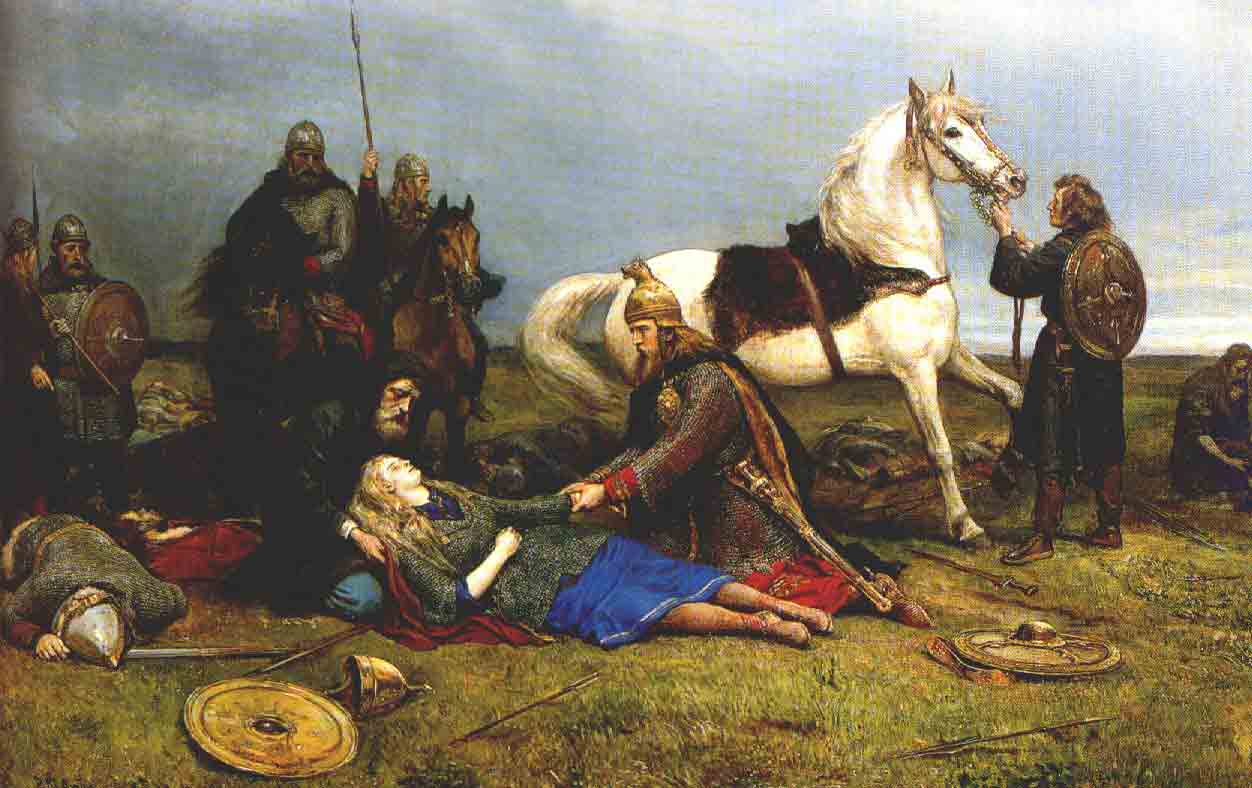In the beginning there was only one universal element: space. Space was a vacuum, an empty void existing in complete equilibrium, a steady state of nothingness. There was no matter, no light, no time, no change. The Unknown Demiurge created what we know as the universe when it introduced three additional elements: time, energy, and matter.
The three primary elements mixed together and formed chaos at the dawn of creation. The four elements eventually coalesced into the universe. Into this early universe were born cosmic beings of immense power: the Elder Gods. The Elder Gods were embodiments of universal forces that existed long before Earth or Man. They are completely neutral and indifferent towards men. Though some men have learned to bend the will of these cosmic forces to their own ends, the sheer incomprehensibility of these deities tend to drive these supplicants mad.
It was the Elder Gods that created the Day Star and the Earth and the other worlds. As they created, they spawned new gods, personifications and embodiments of their creations. Thus were created the Greater Gods: Tzann, Gaia, Thumina, Darkun and others. These gods are vast and impersonal, remote and unapproachable. They are generally indifferent to the affairs of man but may occasionally be swayed by the offering of sacrifice.
It was the union of Tzann and Gaia that created Quintessence, the fifth element, the spark of life. In so doing, she populated the world of Earth with flora and fauna, each possessing a consciousness and soul.
Eventually, life evolved into man. With the coming of man came the spontaneous creation of the New Gods, the embodiments and personifications of human concepts such as war, love, scholarship, etc. These gods are increasingly anthropomorphic and relatable. They are the easiest to appease and to sway.
Gods of Law
Tzann (Greater Deity, The God of Order and Leadership and Fate)Tzann is the king of the gods and ruler of the Overworld. It is Tzann that created the great clockwork mechanism of the universe and set the celestial bodies in motion. Tzann is the god of the day star. He is portrayed as a radiant leonine father figure with a muscular build and armor of gold. His wife is Gaia, goddess of nature and mother of all life above ground. Tzann is the brother of Thuminia, goddess of the moon.
Justica (New Deity, Goddess of Justice and Fairness)
The judge of the guilty and the innocent, Justica carries a scale in her right hand and a double-edged sword in her left hand. She has a third eye in the center of her forehead with which she sees truth and falsehood.
Gaia (Greater Deity, Goddess of Nature)
Gaia is generally depicted as a full-figured wide-hipped large-bosomed green-skinned woman. She is the goddess of nature and fertility. Gaia is the wife of Zonn, with whom she conceived and gave birth to quintessence, the spark of life that imbues all living and growing things.
Thumina (Greater Deity, Goddess of the Moon)
Thumina is the sister of Tzaan. Thumina is a faintly luminous with pale skin and stiff unmoving hair like carved marble and dark blue-grey eyes. Thumina is the goddess of of the moon as well as obligation, womanhood, and zooanthropes. Thumina is wed to Darkun, the god of the night and shadows.
Ohma Tor, The Beast Lord (Greater Deity, God of Wild Animals)
Wolf-headed lord of the animals and the wilds. Savage and wild defender of the beasts. Hunters offer to him, for if they do not, he may deem your kill an affront and exact his revenge.
The Lady Issarii, Patron Saint of Women Warriors (Demi-goddess)
The greatest human woman warrior of the ancient Agarthan Empire who lead the fight against the Giants of Tor-morain. Revered as a heroic legend by all and worshipped as a goddess by many women warriors.
Artorius (Lesser Deity, God of War)
Artorius is portrayed as a tall mighty warrior in gleaming armor wielding a massive spear known as Mizrak. Artorius has long curly hair and beard and his eyes burn like coals. His skin is bright red and hot enough to burn trees and boil water.
Ordain Stonesheild (Lesser Deity, Dwarven Lord of the Mountain)
Father of the Dwarves and The Goblin Scourge. Lost his left hand in a fight with the Goblin King, Azurg, but won the rights to the mountains for his people in the process.
Adhinata (Lesser Deity, God of Pain, Domination, Mutilation, and Suffering)
Adhinata, also known as “the Flayed God”, is a leather-clad figure of horror with flayed skin covered in nails. He is worshipped by conquerors, torturers, and some decadent nobles. He is also seen as the god of penance, guilt, and suffering. His worshippers perform rites of flagellation and self-mutilation to shed themselves of their sins. The more decadent worshippers inflict suffering on others as a means of reinforcing their own dominance and control.
Gods of Chaos
Darkun (Greater Deity, God of the Night and Shadow)
Darkun is a tall gaunt figure with dark blue skin and black hair. He has a hundred eyes. He wears a long cloak of glittering stars. Darkun is the enemy of Zonn. Long ago, Zonn and Darkun reached an accord that resulted in a sharing agreement over the world. Zonn would rule half of the time, called Day, while Darkun ruled the other half, called Night. Darkun is married to Thumina, goddess of the moon.
Saprin Pang (Lesser Deity, Embodiment of Wine & Debauchery)
Satyr-like deity that variously appears as either a male or female. Known to seduce (or attempt to) the most attractive of mortals (Charisma 17 or above). His/Her children, the Sarpin, are said to be the inspiration of drunken lust. They whisper in the ear of those addled with drink and talk them into things they may regret.
Set (Lesser Deity, God of Serpents and Lies)
Set is the god of serpents. He has the form of a giant serpent with hundreds of human arms. He is also the god of assassins, lies, snake-worshippers, shape-changers, and alchemy.
Lorimes the Lord of Ravens (Greater Deity, God of Magic)
His representation shifts continuously; he may appear as a 10-year-old girl, a wizened old man, or anything in between. He always has a robe of a hue that you can never entirely pin down, a raven on his shoulder and a bone-white staff. He is steeped in arcana and tends to spend half his time looking into planes other than our own – he is often holding two conversations at once, with creatures in two different planes. It is dangerous to call on him, as he is impatient of being interrupted in his studies, but if you ask a clever question or have a situation that engages his interest (for example, you have summoned a golem that is proving truculent and particularly difficult to banish), he may give you a reward, for he has studied much and finds little that is new. To summon him, it is easiest to call to his raven by sacrificing a jewel-encrusted rodent and invoking a spell known only to higher-level adepts. Often, only his raven will appear, and it will decide whether it is worth summoning Lorimes. It is a powerful creature in its own right, though, and may be able to help without referring to its master.
Shaitain the Destroyer (Elder Deity, God of Entropy, Chaos, and Destruction)
Shaitan is one of the powerful titans that pre-date the gods. He is a primordial force embodying entropy and decay. He devours life, energy, and vitality. He is the end of all things and will one day return the universe to universal equilibrium. Shaitan is only worshipped by madmen and certain suicidal cults.
Neutral Gods
Fang Drako (Greater Deity, God of the Dragons, The First Wyrm)
Ancient and huge dragon that is said to imprisoned within in the center of the world. His flame is seen in the fury of volcanoes and his rage is the earthquakes that tumble the mightiest of empires. Sacrifices are made monthly at the base of each of the volcanic mountains of the Great Wall to slake his rage lest he make the lands quake and the volcanoes burn!
Nil the Queen of Death (Greater/Lesser Deity, Goddess of Death)
A tall, green figure in blue robes with a sceptre of justice in her hand and a fierce and forbidding visage. She has as deep a commitment to justice in the afterlife as Justica has in this life. She is assisted by the conductor, Syrrhus, a man all in gray often pictured as riding a swift hart, and by the wizened, ink-stained recordkeeper, Corprus. Her worshippers are known for not being judgmental, for nothing can be valued until its end is known and all can be taken into account. She is more of a neutral figure than lawful good: it is important that people gain a reward that fits their actions during life, but if an evil person gets an evil afterlife, there is no revenge or satisfaction in that; it just is so.
Amun Tor (Lesser Deity, God of Mysteries and Riddles)
Amun Tor is a mysterious hooded figure with one great eye. He is the god of scholars, explorers, and secrets. He is a reclusive god in charge of the secret library of heaven. It is said that Amun Tor is fond of puzzles, riddles, and games and many myths tell stories of wily heroes that best the god using cunning, strategy, and trickery. These heroes in turn have provided men with the knowledge of fire, magic, agriculture, and other advances.
Xulutc, the God Between the Stars (Elder Deity, God of the Void)
An alien being, a winged tentacled horror from outer space, ruler of the Outerworld.
Quarin the Evergreen, aka the Elf King (Lesser Deity, God of the Fey)
Quarin is a tall muscular figure with pale skin like marble. He has long flowing white hair and a beard. A massive rack of antlers sprout from his head. Giant hawk wings grow from his shoulders. Quarin is the ruler of the Otherworld, also known as Elfland or Fairy-land. He is the god of elves, fairies, sprites, and fey creatures.
Draven Windshard (Demi-God, Patron Deity of Half-elves, Stories, Bards, History, and Lore)
Half-elf hero and demi-god, was the Master Storyteller. Said to still roam the lands looking for new heroes stories to tell, even though he would be centuries old now.
Azurg, The Goblin King (Lesser Deity, God of the Goblins)
Wily and sly, Azurg attempted to cheat the dwarves of their mountain homes at the creation of the world. He is now a hideous old Goblin covered in burn scars.
















